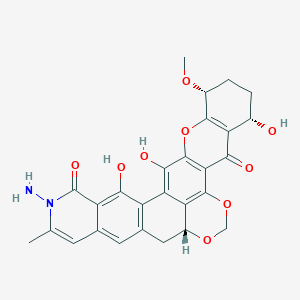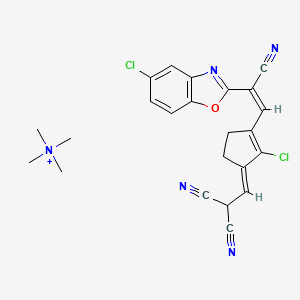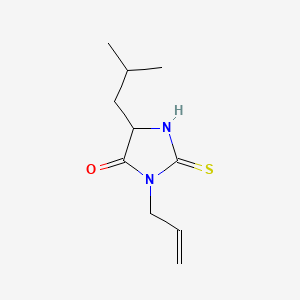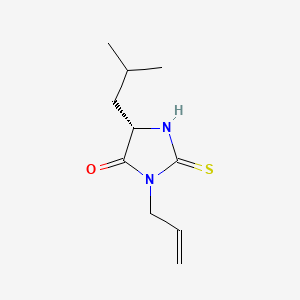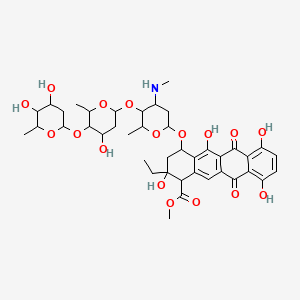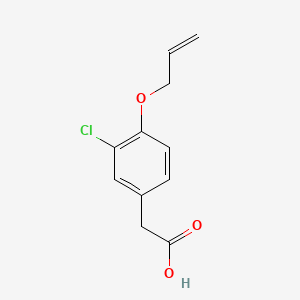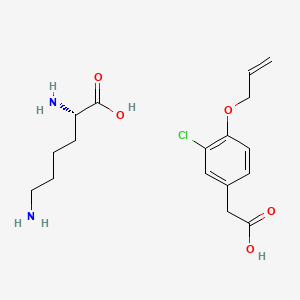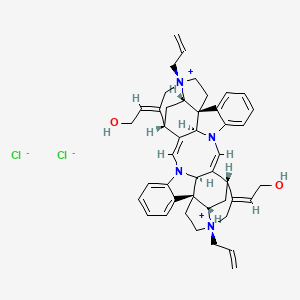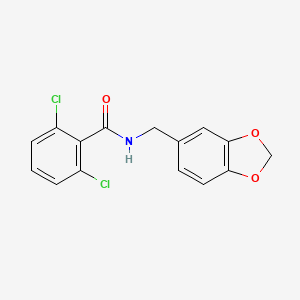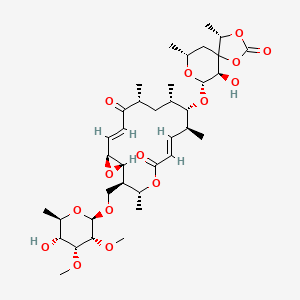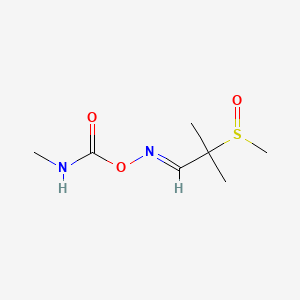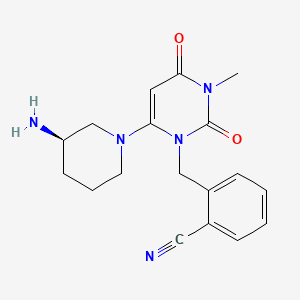
アログリプチン
概要
説明
アログリプチンは、ジペプチジルペプチダーゼ-4(DPP-4)阻害薬クラスに属する経口糖尿病治療薬です。主に、2型糖尿病患者の高血糖の管理に使用されます。アログリプチンは、グルコース依存性インスリン分泌促進ポリペプチド(GIP)およびグルカゴン様ペプチド-1(GLP-1)などのインクレチンホルモンを通常分解するDPP-4酵素を阻害することで作用します。DPP-4を阻害することにより、アログリプチンは活性なインクレチンホルモンのレベルを高め、それによりグルコース依存的な方法でインスリン分泌を促進し、グルカゴンレベルを低下させます .
作用機序
アログリプチンは、インクレチンホルモンの分解に関与するDPP-4酵素を阻害することでその効果を発揮します。DPP-4を阻害することにより、アログリプチンはGLP-1やGIPなどの活性なインクレチンホルモンのレベルを高めます。これらのホルモンは、膵臓のβ細胞からのインスリン分泌を促進し、膵臓のα細胞からのグルカゴン分泌を抑制し、血糖コントロールを改善します。アログリプチンによるDPP-4の阻害は、活性なインクレチンレベルの延長にもつながり、その治療効果に貢献します .
科学的研究の応用
Alogliptin has a wide range of scientific research applications, including:
生化学分析
Biochemical Properties
Alogliptin interacts with the enzyme dipeptidyl peptidase-4 (DPP-4). This enzyme normally degrades the incretins glucose-dependent insulinotropic polypeptide (GIP) and glucagon-like peptide 1 (GLP-1). Alogliptin inhibits DPP-4, thereby increasing the levels of these incretins .
Cellular Effects
Alogliptin has been shown to have effects on various types of cells and cellular processes. It influences cell function by increasing the levels of incretins, which in turn help the body produce more insulin and stop the body from releasing too much sugar into the blood . This helps keep blood sugar levels stable.
Molecular Mechanism
The molecular mechanism of action of Alogliptin involves the inhibition of the DPP-4 enzyme. This inhibition results in prolonged active incretin levels, which help the body produce more insulin and stop the body from releasing too much sugar into the blood .
Temporal Effects in Laboratory Settings
In laboratory settings, peak inhibition of DPP-4 occurs within 2-3 hours after a single-dose administration of Alogliptin to healthy subjects. The peak inhibition of DPP-4 exceeded 93% across doses of 12.5 mg to 800 mg. Inhibition of DPP-4 remained above 80% at 24 hours for doses greater than or equal to 25 mg .
Dosage Effects in Animal Models
While specific studies on the dosage effects of Alogliptin in animal models were not found, it is generally recommended that the dosage of Alogliptin be adjusted based on the patient’s kidney function .
Metabolic Pathways
Alogliptin is involved in the metabolic pathway related to the regulation of blood sugar levels. It interacts with the DPP-4 enzyme and incretins such as GIP and GLP-1 .
Transport and Distribution
Alogliptin is well distributed into tissues. Following a single, 12.5 mg intravenous infusion of Alogliptin to healthy subjects, the volume of distribution during the terminal phase was 417 L .
Subcellular Localization
As a small molecule drug, Alogliptin is likely to be distributed throughout the cell, where it can interact with its target, the DPP-4 enzyme .
準備方法
合成経路と反応条件
アログリプチンは、重要な中間体の形成を含む複数段階のプロセスによって合成されます。合成経路は通常、2-({6-[(3R)-3-アミノピペリジン-1-イル]-3-メチル-2,4-ジオキソ-3,4-ジヒドロピリミジン-1(2H)-イル}メチル)ベンゾニトリルの調製から始まります。この中間体は、アミノ化および環化などのさまざまな化学反応にさらされて、最終生成物が得られます .
工業生産方法
工業的な設定では、アログリプチンの生産には、精製と品質管理のために高速液体クロマトグラフィー(HPLC)が使用されます。このプロセスは、最終生成物の高収率と純度を確保するために最適化されています。逆相HPLC(RP-HPLC)などの高度な分析技術の使用は、アログリプチンの工業生産において一般的です .
化学反応の分析
反応の種類
アログリプチンは、以下を含むさまざまな化学反応を起こします。
酸化: アログリプチンは、特定の条件下で酸化されて対応する酸化物を形成することができます。
還元: 還元反応は、アログリプチンの官能基を修飾するために使用できます。
一般的な試薬と条件
アログリプチンの化学反応で使用される一般的な試薬には、以下が含まれます。
酸化剤: 過酸化水素や過マンガン酸カリウムなど。
還元剤: 水素化ホウ素ナトリウムや水素化リチウムアルミニウムなど。
置換剤: ハロゲンやアルキル化剤など
生成される主な生成物
アログリプチンの化学反応から生成される主な生成物は、使用される特定の反応条件と試薬によって異なります。たとえば、酸化により酸化物が生成され、置換反応によりハロゲン化またはアルキル化された誘導体が生成される場合があります .
科学研究への応用
アログリプチンは、以下を含む幅広い科学研究への応用を持っています。
類似化合物との比較
アログリプチンは、DPP-4阻害薬クラスの一部であり、以下のような他の類似化合物も含まれています。
- シタグリプチン
- サクサグリプチン
- リナグリプチン
- ビルダグリプチン
アログリプチンの独自性
アログリプチンは、高い選択性と経口バイオアベイラビリティにより、DPP-4阻害薬の中で独特です。比較的長い半減期があり、1日1回の投与が可能です。さらに、アログリプチンは、低血糖のリスクが低く、体重への影響が最小限であるため、安全性の高いプロファイルを示すことが示されています .
特性
IUPAC Name |
2-[[6-[(3R)-3-aminopiperidin-1-yl]-3-methyl-2,4-dioxopyrimidin-1-yl]methyl]benzonitrile | |
|---|---|---|
| Source | PubChem | |
| URL | https://pubchem.ncbi.nlm.nih.gov | |
| Description | Data deposited in or computed by PubChem | |
InChI |
InChI=1S/C18H21N5O2/c1-21-17(24)9-16(22-8-4-7-15(20)12-22)23(18(21)25)11-14-6-3-2-5-13(14)10-19/h2-3,5-6,9,15H,4,7-8,11-12,20H2,1H3/t15-/m1/s1 | |
| Source | PubChem | |
| URL | https://pubchem.ncbi.nlm.nih.gov | |
| Description | Data deposited in or computed by PubChem | |
InChI Key |
ZSBOMTDTBDDKMP-OAHLLOKOSA-N | |
| Source | PubChem | |
| URL | https://pubchem.ncbi.nlm.nih.gov | |
| Description | Data deposited in or computed by PubChem | |
Canonical SMILES |
CN1C(=O)C=C(N(C1=O)CC2=CC=CC=C2C#N)N3CCCC(C3)N | |
| Source | PubChem | |
| URL | https://pubchem.ncbi.nlm.nih.gov | |
| Description | Data deposited in or computed by PubChem | |
Isomeric SMILES |
CN1C(=O)C=C(N(C1=O)CC2=CC=CC=C2C#N)N3CCC[C@H](C3)N | |
| Source | PubChem | |
| URL | https://pubchem.ncbi.nlm.nih.gov | |
| Description | Data deposited in or computed by PubChem | |
Molecular Formula |
C18H21N5O2 | |
| Source | PubChem | |
| URL | https://pubchem.ncbi.nlm.nih.gov | |
| Description | Data deposited in or computed by PubChem | |
DSSTOX Substance ID |
DTXSID90234130 | |
| Record name | Alogliptin | |
| Source | EPA DSSTox | |
| URL | https://comptox.epa.gov/dashboard/DTXSID90234130 | |
| Description | DSSTox provides a high quality public chemistry resource for supporting improved predictive toxicology. | |
Molecular Weight |
339.4 g/mol | |
| Source | PubChem | |
| URL | https://pubchem.ncbi.nlm.nih.gov | |
| Description | Data deposited in or computed by PubChem | |
Solubility |
Sparingly soluble | |
| Record name | Alogliptin | |
| Source | DrugBank | |
| URL | https://www.drugbank.ca/drugs/DB06203 | |
| Description | The DrugBank database is a unique bioinformatics and cheminformatics resource that combines detailed drug (i.e. chemical, pharmacological and pharmaceutical) data with comprehensive drug target (i.e. sequence, structure, and pathway) information. | |
| Explanation | Creative Common's Attribution-NonCommercial 4.0 International License (http://creativecommons.org/licenses/by-nc/4.0/legalcode) | |
Mechanism of Action |
Alogliptin inhibits dipeptidyl peptidase 4 (DPP-4), which normally degrades the incretins glucose-dependent insulinotropic polypeptide (GIP) and glucagon like peptide 1 ( GLP-1). The inhibition of DPP-4 increases the amount of active plasma incretins which helps with glycemic control. GIP and GLP-1 stimulate glucose dependent secretion of insulin in pancreatic beta cells. GLP-1 has the additional effects of suppressing glucose dependent glucagon secretion, inducing satiety, reducing food intake, and reducing gastric emptying., Increased concentrations of the incretin hormones such as glucagon-like peptide-1 (GLP-1) and glucose-dependent insulinotropic polypeptide (GIP) are released into the bloodstream from the small intestine in response to meals. These hormones cause insulin release from the pancreatic beta cells in a glucose-dependent manner but are inactivated by the DPP-4 enzyme within minutes. GLP-1 also lowers glucagon secretion from pancreatic alpha cells, reducing hepatic glucose production. In patients with type 2 diabetes, concentrations of GLP-1 are reduced but the insulin response to GLP-1 is preserved. Alogliptin is a DPP-4 inhibitor that slows the inactivation of the incretin hormones, thereby increasing their bloodstream concentrations and reducing fasting and postprandial glucose concentrations in a glucose-dependent manner in patients with type 2 diabetes mellitus. Alogliptin selectively binds to and inhibits DPP-4 but not DPP-8 or DPP-9 activity in vitro at concentrations approximating therapeutic exposures. | |
| Record name | Alogliptin | |
| Source | DrugBank | |
| URL | https://www.drugbank.ca/drugs/DB06203 | |
| Description | The DrugBank database is a unique bioinformatics and cheminformatics resource that combines detailed drug (i.e. chemical, pharmacological and pharmaceutical) data with comprehensive drug target (i.e. sequence, structure, and pathway) information. | |
| Explanation | Creative Common's Attribution-NonCommercial 4.0 International License (http://creativecommons.org/licenses/by-nc/4.0/legalcode) | |
| Record name | Alogliptin | |
| Source | Hazardous Substances Data Bank (HSDB) | |
| URL | https://pubchem.ncbi.nlm.nih.gov/source/hsdb/8203 | |
| Description | The Hazardous Substances Data Bank (HSDB) is a toxicology database that focuses on the toxicology of potentially hazardous chemicals. It provides information on human exposure, industrial hygiene, emergency handling procedures, environmental fate, regulatory requirements, nanomaterials, and related areas. The information in HSDB has been assessed by a Scientific Review Panel. | |
CAS No. |
850649-61-5 | |
| Record name | Alogliptin | |
| Source | CAS Common Chemistry | |
| URL | https://commonchemistry.cas.org/detail?cas_rn=850649-61-5 | |
| Description | CAS Common Chemistry is an open community resource for accessing chemical information. Nearly 500,000 chemical substances from CAS REGISTRY cover areas of community interest, including common and frequently regulated chemicals, and those relevant to high school and undergraduate chemistry classes. This chemical information, curated by our expert scientists, is provided in alignment with our mission as a division of the American Chemical Society. | |
| Explanation | The data from CAS Common Chemistry is provided under a CC-BY-NC 4.0 license, unless otherwise stated. | |
| Record name | Alogliptin [INN] | |
| Source | ChemIDplus | |
| URL | https://pubchem.ncbi.nlm.nih.gov/substance/?source=chemidplus&sourceid=0850649615 | |
| Description | ChemIDplus is a free, web search system that provides access to the structure and nomenclature authority files used for the identification of chemical substances cited in National Library of Medicine (NLM) databases, including the TOXNET system. | |
| Record name | Alogliptin | |
| Source | DrugBank | |
| URL | https://www.drugbank.ca/drugs/DB06203 | |
| Description | The DrugBank database is a unique bioinformatics and cheminformatics resource that combines detailed drug (i.e. chemical, pharmacological and pharmaceutical) data with comprehensive drug target (i.e. sequence, structure, and pathway) information. | |
| Explanation | Creative Common's Attribution-NonCommercial 4.0 International License (http://creativecommons.org/licenses/by-nc/4.0/legalcode) | |
| Record name | Alogliptin | |
| Source | EPA DSSTox | |
| URL | https://comptox.epa.gov/dashboard/DTXSID90234130 | |
| Description | DSSTox provides a high quality public chemistry resource for supporting improved predictive toxicology. | |
| Record name | 2-[[6-[(3R)-3-aminopiperidin-1-yl]-3-methyl-2,4-dioxopyrimidin-1-yl]methyl]benzonitrile | |
| Source | European Chemicals Agency (ECHA) | |
| URL | https://echa.europa.eu/information-on-chemicals | |
| Description | The European Chemicals Agency (ECHA) is an agency of the European Union which is the driving force among regulatory authorities in implementing the EU's groundbreaking chemicals legislation for the benefit of human health and the environment as well as for innovation and competitiveness. | |
| Explanation | Use of the information, documents and data from the ECHA website is subject to the terms and conditions of this Legal Notice, and subject to other binding limitations provided for under applicable law, the information, documents and data made available on the ECHA website may be reproduced, distributed and/or used, totally or in part, for non-commercial purposes provided that ECHA is acknowledged as the source: "Source: European Chemicals Agency, http://echa.europa.eu/". Such acknowledgement must be included in each copy of the material. ECHA permits and encourages organisations and individuals to create links to the ECHA website under the following cumulative conditions: Links can only be made to webpages that provide a link to the Legal Notice page. | |
| Record name | ALOGLIPTIN | |
| Source | FDA Global Substance Registration System (GSRS) | |
| URL | https://gsrs.ncats.nih.gov/ginas/app/beta/substances/JHC049LO86 | |
| Description | The FDA Global Substance Registration System (GSRS) enables the efficient and accurate exchange of information on what substances are in regulated products. Instead of relying on names, which vary across regulatory domains, countries, and regions, the GSRS knowledge base makes it possible for substances to be defined by standardized, scientific descriptions. | |
| Explanation | Unless otherwise noted, the contents of the FDA website (www.fda.gov), both text and graphics, are not copyrighted. They are in the public domain and may be republished, reprinted and otherwise used freely by anyone without the need to obtain permission from FDA. Credit to the U.S. Food and Drug Administration as the source is appreciated but not required. | |
| Record name | Alogliptin | |
| Source | Hazardous Substances Data Bank (HSDB) | |
| URL | https://pubchem.ncbi.nlm.nih.gov/source/hsdb/8203 | |
| Description | The Hazardous Substances Data Bank (HSDB) is a toxicology database that focuses on the toxicology of potentially hazardous chemicals. It provides information on human exposure, industrial hygiene, emergency handling procedures, environmental fate, regulatory requirements, nanomaterials, and related areas. The information in HSDB has been assessed by a Scientific Review Panel. | |
Retrosynthesis Analysis
AI-Powered Synthesis Planning: Our tool employs the Template_relevance Pistachio, Template_relevance Bkms_metabolic, Template_relevance Pistachio_ringbreaker, Template_relevance Reaxys, Template_relevance Reaxys_biocatalysis model, leveraging a vast database of chemical reactions to predict feasible synthetic routes.
One-Step Synthesis Focus: Specifically designed for one-step synthesis, it provides concise and direct routes for your target compounds, streamlining the synthesis process.
Accurate Predictions: Utilizing the extensive PISTACHIO, BKMS_METABOLIC, PISTACHIO_RINGBREAKER, REAXYS, REAXYS_BIOCATALYSIS database, our tool offers high-accuracy predictions, reflecting the latest in chemical research and data.
Strategy Settings
| Precursor scoring | Relevance Heuristic |
|---|---|
| Min. plausibility | 0.01 |
| Model | Template_relevance |
| Template Set | Pistachio/Bkms_metabolic/Pistachio_ringbreaker/Reaxys/Reaxys_biocatalysis |
| Top-N result to add to graph | 6 |
Feasible Synthetic Routes
A: [, , , , , , , , ] Alogliptin functions as a highly selective dipeptidyl peptidase-4 (DPP-4) inhibitor. DPP-4 is an enzyme that rapidly inactivates incretin hormones, primarily glucagon-like peptide-1 (GLP-1) and glucose-dependent insulinotropic polypeptide (GIP). By inhibiting DPP-4, alogliptin increases the levels of GLP-1 and GIP, which in turn leads to enhanced insulin secretion from pancreatic beta cells and suppressed glucagon secretion, ultimately resulting in improved glucose homeostasis.
A: The molecular formula of alogliptin benzoate (the active form) is C18H18N6O3 • C7H6O2, and its molecular weight is 462.46 g/mol.
A: While the provided papers don’t delve into detailed formulation strategies for alogliptin, one study explored the use of injectable long-acting poly (lactide-co-glycolide) (PLGA)-based in situ gel implants (ISGI) loaded with alogliptin . This approach aimed to provide sustained therapeutic exposures and improve pharmacological responses, potentially leading to reduced dosing frequency and enhanced patient compliance. The study highlighted the effectiveness of solvents like N-methyl-2-pyrrolidone (NMP) and dimethyl sulfoxide (DMSO) in achieving successful ISGI preparation and controlling the release profile of alogliptin.
A: [, , ] Alogliptin demonstrates moderate absorption, exceeding 75%, and its absorption is not significantly affected by food [, ]. It exhibits slow-binding properties to the DPP-4 enzyme, resulting in sustained reduction of plasma DPP-4 activity . Alogliptin has low plasma protein binding . Although the provided papers don't extensively detail its metabolism, they indicate that alogliptin is primarily excreted renally .
A: Research indicates that creatinine clearance and weight can significantly influence the oral clearance (CL/F) of alogliptin . This suggests that dose adjustments may be necessary for patients with renal impairment, while weight-based adjustments are generally not clinically relevant.
A: [, ] Studies haven't identified any significant drug interactions with alogliptin monotherapy [, ]. Notably, it can be co-administered with medications like ketoconazole, fluconazole, gemfibrozil, warfarin, metformin, glyburide, and pioglitazone without requiring dosage adjustments .
A: A study using diabetic apolipoprotein E-deficient mice showed that alogliptin treatment effectively reduced atherosclerotic lesions . This protective effect was linked to alogliptin's ability to lower plasma glucose levels and attenuate the expression of inflammatory cytokines (IL-6 and IL-1β) within the atherosclerotic plaques.
A: Research in rabbits suggests that alogliptin exhibits cardioprotective effects against ischemia-reperfusion injury . The study attributed these benefits to alogliptin's ability to enhance nitric oxide production through both GLP-1 receptor-dependent and -independent pathways. This increased nitric oxide production was associated with improved left ventricular ejection fraction and ±dP/dt, indicating enhanced cardiac function.
A: [, , , , , , , , , , ] Numerous clinical trials have demonstrated the efficacy of alogliptin in improving glycemic control in patients with type 2 diabetes. Alogliptin, as monotherapy or in combination with other antidiabetic agents, consistently led to significant reductions in HbA1c levels [, , , , , , , , , , ]. Studies also highlight its efficacy in specific patient populations, such as those with inadequate glycemic control on metformin [, , ] or those receiving insulin therapy .
A: While traditional oral formulations of alogliptin are available, researchers are investigating injectable long-acting PLGA-based ISGI as a potential alternative delivery system. This approach aims to enhance patient compliance and potentially improve the therapeutic outcomes by achieving sustained drug release.
A: Research suggests that urinary angiotensinogen (AGT) levels could potentially serve as a prognostic marker for the renoprotective effects of alogliptin in patients with type 2 diabetes . The study observed a correlation between higher baseline urinary AGT levels and a more pronounced decrease in urinary albumin-to-creatinine ratio (UACR) following alogliptin treatment. This finding implies that urinary AGT could potentially help identify patients who are more likely to benefit from the renoprotective effects of alogliptin.
A: [, , ] Several analytical methods have been developed and validated for the quantification of alogliptin, including:
- UV Spectrophotometry: This technique utilizes the absorbance of UV-visible light by alogliptin at specific wavelengths for its quantification. It's a simple and cost-effective method often used for routine analysis of alogliptin in pharmaceutical formulations. [, ]
- High-Performance Thin-Layer Chromatography (HPTLC): HPTLC is a versatile technique that separates and quantifies alogliptin based on its differential migration on a thin layer of adsorbent material.
- Reverse-Phase High-Performance Liquid Chromatography (RP-HPLC): RP-HPLC offers high sensitivity and selectivity in separating and quantifying alogliptin in complex matrices like pharmaceutical formulations and biological samples. It's often coupled with UV detection for quantification. [, ]
- Liquid Chromatography-Tandem Mass Spectrometry (LC-MS/MS): LC-MS/MS provides exceptional sensitivity and specificity for quantifying alogliptin in biological matrices, particularly at low concentrations. It's often the preferred method for pharmacokinetic studies.
A: [, , ] The development and validation of analytical methods for alogliptin quantification involve assessing key validation parameters as outlined by regulatory guidelines, such as the International Conference on Harmonisation (ICH) guidelines. These parameters include:
A: [, , , , ] Several alternatives to alogliptin are available for managing type 2 diabetes, including:
- Other DPP-4 Inhibitors: As mentioned earlier, other DPP-4 inhibitors like sitagliptin, vildagliptin, saxagliptin, and linagliptin offer similar mechanisms of action and comparable efficacy to alogliptin in terms of HbA1c reduction. [, , , , ]
- Metformin: Metformin is a first-line treatment for type 2 diabetes that improves insulin sensitivity and reduces hepatic glucose production. It is often used in combination with DPP-4 inhibitors or GLP-1 receptor agonists. [, ]
A: [, ] Alogliptin received approval from the US Food and Drug Administration (FDA) for the treatment of type 2 diabetes in 2013. [, ]
試験管内研究製品の免責事項と情報
BenchChemで提示されるすべての記事および製品情報は、情報提供を目的としています。BenchChemで購入可能な製品は、生体外研究のために特別に設計されています。生体外研究は、ラテン語の "in glass" に由来し、生物体の外で行われる実験を指します。これらの製品は医薬品または薬として分類されておらず、FDAから任何の医療状態、病気、または疾患の予防、治療、または治癒のために承認されていません。これらの製品を人間または動物に体内に導入する形態は、法律により厳格に禁止されています。これらのガイドラインに従うことは、研究と実験において法的および倫理的な基準の遵守を確実にするために重要です。


